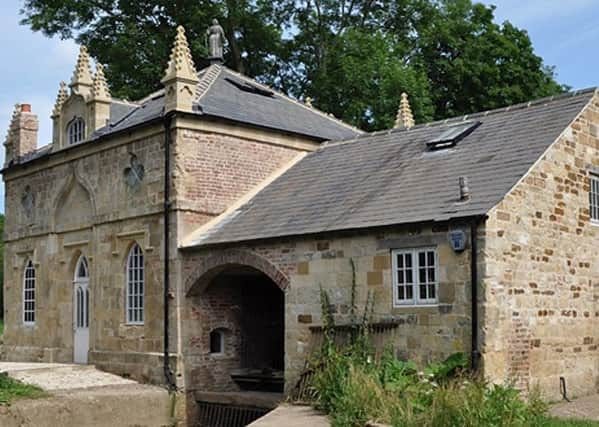Your Day Out: Village of Howsham is full of history


Attractive dwellings in Howsham, you’ll notice, are all on one side of a single street. Houses were once on the other side too, but these were removed about 1770 by the landlord, Nathaniel Cholmley. He wished to improve the view of the countryside from his windows in the Jacobean residence of Howsham Hall. He had trees planted in their place. Enjoy this well-cared for village which once won the best-kept village award. Cottages climb the lane, almost in step fashion, facing the trees bordering the eastern side of the park. Houses are built of local Jurassic stone of an attractive amber-tinted colour.
With them, is a stone pillar or sandstone monolith near the church. It’s in memory of one man – a war memorial to a single man who fell in the First World War, and the supreme sacrifice made by John Midgley. The church of St John was built in 1860 for Hannah Cholmley of Howsham Hall. The architect was GE Street. Take a look inside, as the bright glass adds a cheerful touch to the interior. The tower has a colonnaded belfry and a spire. Beside it is a loggia with stone pillars supporting a sloping roof.
Advertisement
Hide AdAdvertisement
Hide AdIn this small village was born George Hudson in 1800 who became famous as the ‘Railway King’. Sadly, he lost his mother at the age of six, and within two years later, his father died. The orphan was left in the care of his elder brothers, John and William, who then had to run the farm. Entering his teens he was pretty much left to his own devices and got a girl into trouble when he was 15.
He was sent away to York to make his own way in the world. Having great drive and determination, and ability in large scale planning, he unfortunately had no regard for the formalities of accounting procedures.
George began work in Bell and Nicholson’s draper’s shop. He became Lord Mayor of York three times, and even had a street named after him.
In the railway boom of 1845/6 he misused shareholders’ money and had to leave the country in disgrace. He lived the rest of his life until 1871 in comparative poverty, and was buried in his native countryside down river at Scrayingham.
Advertisement
Hide AdAdvertisement
Hide AdHis coffin was transported to York Station where the funeral procession began. The hearse was drawn by four horses to Scrayingham, where he was buried in the family vault.
From Howsham’s very solid bridge over the River Derwent, there’s a short, pleasant walk indicated north through pastureland to a fine bridge and riverside woodland to the weir. This must be seen! For over 200 years, from about 1740, a water mill grinding corn, operated here on the village side of the river. A cut, by-passing the weir and the mill allowed access to a lock for vessels on the Derwent navigation, which operated commercially from about the middle of the 18th century, until competition from railways. This caused its decline 100 years later, and its end in the early part of the 20th century. The short stretch of white water at the weir, has long attracted canoeists.
Michael well remembers going to the old mill with his dad to grind corn, around 1941. It later fell into ruins, and became engulfed in straggling vegetation. The building was wrecked to obtain scrap metal, and the machinery stolen, but this Ryedale treasure, tucked away on an island in the River Derwent has been removed.
Dave Mann and Mo MacLeod purchased the old mill, and along with conservation workers and volunteers, have over the years achieved what seemed a pipe-dream! Howsham Mill is reborn. Go, and discover for yourself the dramatic changes amazingly achieved through inspiration and sheer dedication to the project.
Advertisement
Hide AdAdvertisement
Hide AdShould time permit, to complete your day out, I suggest you visit Scrayingham to see George Hudson’s grave.
There is a signed public footpath beside the bridge which accompanies the River Derwent to Scrayingham, but it was the summer of 1991 when we last enjoyed the walk. I can’t therefore comment on the route now, but do explore it on a fine day.
l George Hudson had been accused of dishonest activities, and the misappropriation of half a million pounds. He lost in the 1857 elections; fled to Paris; lived in poverty until 1885, and was imprisoned in York for a time. He died on December 14, 1871 – a man with vision and energy.
As we stood in Scrayingham’s churchyard by the Hudson vault, we felt there lay a great man, who was after all only human like each and every one of us.